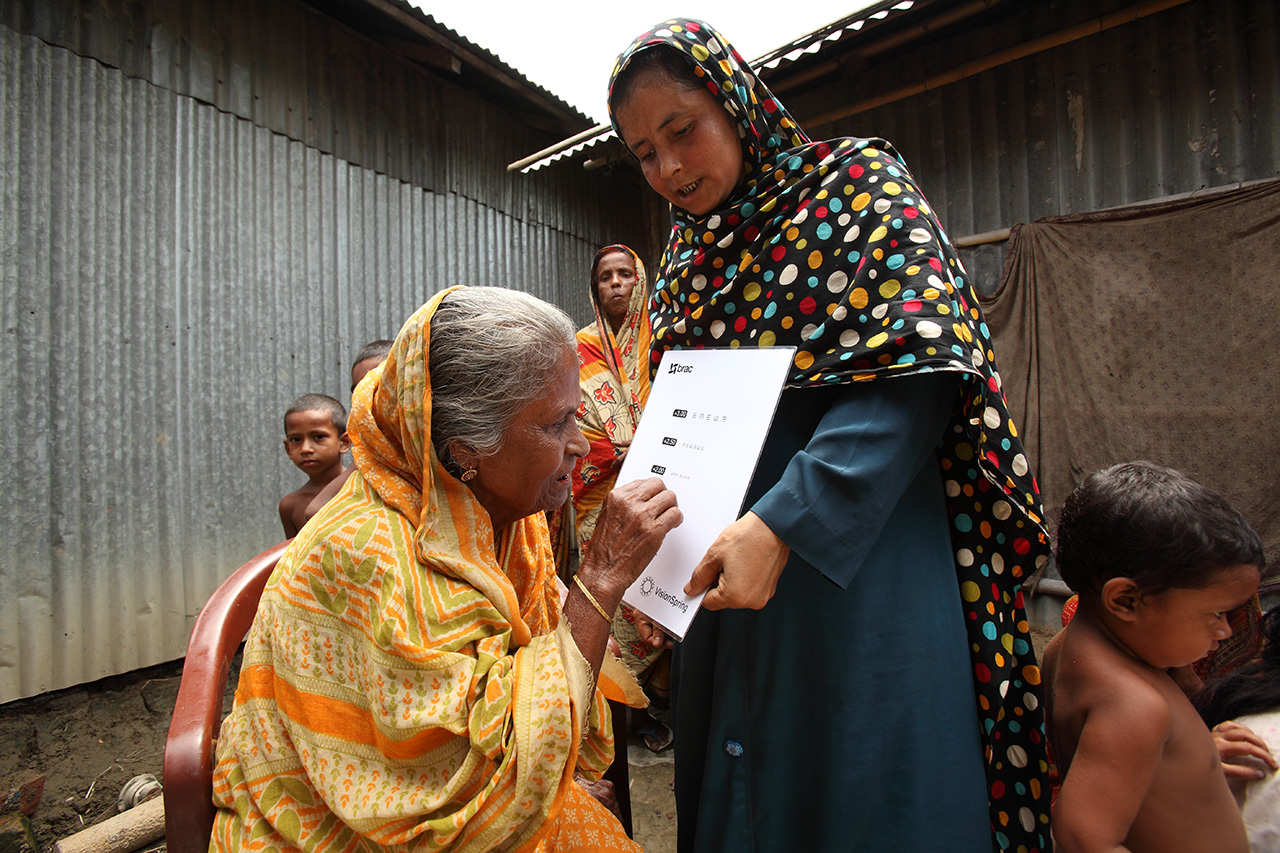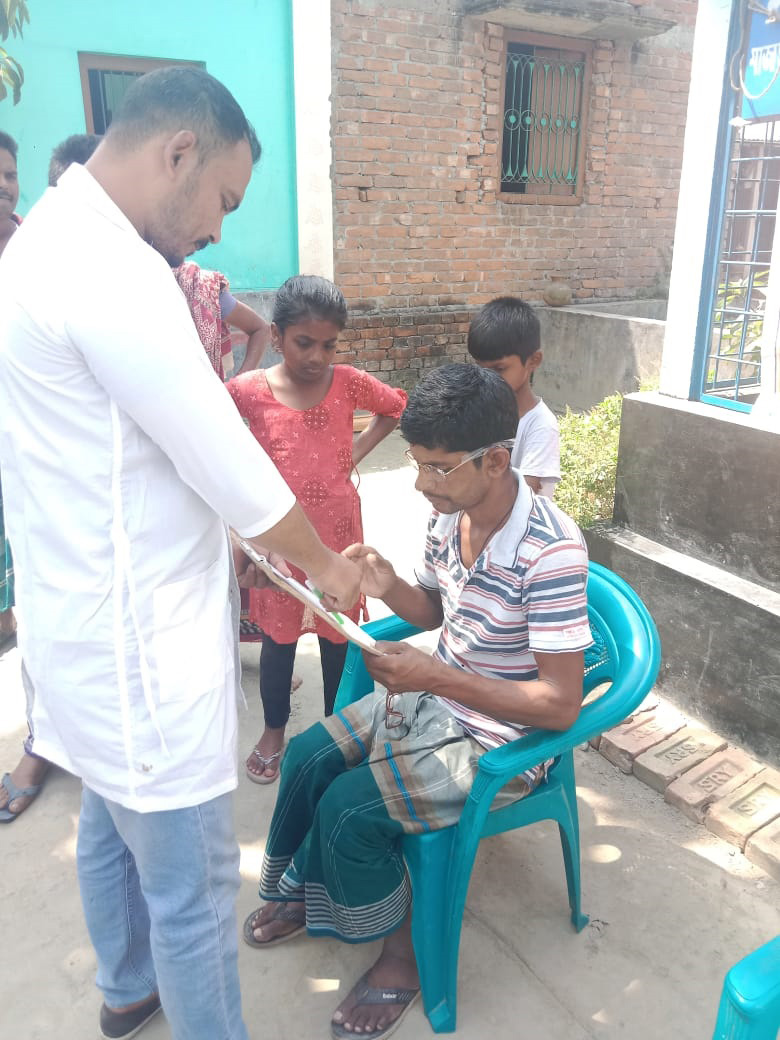Correcting the eyesight of 2 million people
Reading Time: 3 minutes
One in five people in Bangladesh suffer from presbyopia, a condition which makes seeing things difficult up close – and can heavily impact livelihood opportunities. BRAC, in partnership with VisionSpring, and a cadre of community health workers, took to communities in Bangladesh in 2006 with a radical idea of ‘demedicalising’ the treatment of presbyopia. Less than 20 years later, this has resulted in two million people in Bangladesh being able to see better.
Presbyopia.
Don’t let the medical term scare you off.
If you are reading this article with reading glasses, chances are you have presbyopia. Globally, the condition affects almost 1.8 billion people.
One in five people in Bangladesh suffer from presbyopia. This figure includes more than half the adult population, according to research conducted by VisionSpring and BRAC.
An age-degenerative condition, presbyopia tends to start affecting people at age 35-40 – when they are at the peak of economic productivity. It’s a silent epidemic, for which not only individuals, but the economy overall, pays the price.
Fighting scale with scale
In 2006, BRAC partnered with VisionSpring, with a simple idea – to de-medicalise the delivery of glasses – an over-the-counter product which was stuck in optical shops and eye hospitals in Bangladesh.

BRAC’s community health workers conduct eye tests to detect presbyopia among community members.
Community health workers were trained to conduct basic vision tests, dispense reading glasses and refer people to higher level services if they needed specialist care. The pilot started in just two sub-districts of Manikganj district in Bangladesh, soon scaled up to eight, then reached 24 – and finally reached 61 of Bangladesh’s 64 districts in 2014.
Over 32,000 community health workers now take the blessing of clear vision to their communities as part of their regular visits. The number of people who can see better courtesy of reading glasses dispensed by BRAC’s community health workers reached two million in 2022.
The key to the successful scaling was in the understanding of the situation on the ground.
Community health workers took eye hospitals to the courtyards in their own communities. This ensured access to glasses at places that people were already familiar with. Local newspapers and religious scriptures were used as materials for reading tests – again, for familiarity.
Community health workers had regular access to patients, because they already visited their homes regularly for general health needs. They used those visits to follow up with patients. The feedback from those visits was sent back up to the project supervisors, creating a robust bottom-up chain that allowed for changes to be made to the project in a timely manner.
If I can see, I can earn
Even for people with the clearest of vision, threading a needle is tricky business.
Threading one at the kind of awkward angle required for a sewing machine is much trickier business.
For Md Faruk, a tailor from Manikganj in Bangladesh, it’s an effortless task. His hands move as if by magic, effortlessly threading needles with all different thicknesses of thread without even looking sometimes. It’s a far cry from a few years ago.

Md Faruk tests out his new glasses he got from the community health worker.
Faruk migrated at a young age to Abu Dhabi, where he trained to become a tailor. He worked for a few years, before returning to use his skills in his home country.
He set up a tailoring shop in his hometown, and business boomed. Over time however, things changed. It was gradual. At first, Faruk started to experience severe headaches. He thought it was because of overwork.
Then, when he was threading the needle of his sewing machine one afternoon, he missed. It took him 15 tries to get it. From then on, his eyesight deteriorated.
Faruk heard about an upcoming eye camp in his neighbour’s courtyard, and went along for an eye check. He was diagnosed with presbyopia. It was a quick fix – eye glasses were on sale, he bought a pair and was threading needles again that same week.
A common condition, with a common correction – if you can access glasses
One in every four people worldwide are presbyopic, and these numbers are rising as the world’s population ages. Of the 1.8 billion presbyopes worldwide, an estimated 826 million have near visual impairment due to a lack of, or inadequate, near vision correction. People living in lower-income countries are more likely to fall into this category, based on health expenditure and access, as opposed to those residing in higher-income countries. Up to 94% of people in lower-income countries may have vision impairment as a result of under-corrected or uncorrected presbyopia, compared to 4% in Europe, for example. Insights from Bangladesh could help to correct this imbalance, taking glasses to the people who need them, and boosting the quality of people’s lives and livelihoods.
BRAC Health Nutrition and Population Programme caters to the healthcare needs of over 80 million people across Bangladesh, through a combination of community-based and facility-based services. Its community-driven healthcare approach employs 50,000 community health workers and volunteers who deliver quality affordable care to populations living in the most deprived and vulnerable conditions. BRAC’s community health workers are all women, who deliver door-to-door primary and essential healthcare, and facilitate linkages with formal providers.
Rahanuma Anjala is a programme manager of the health, nutrition and population programme at BRAC
Dr. Mithun Gupta is a programme manager of the health, nutrition and population programme at BRAC





